Comprehensive Analysis of SASOL's Global Business Environment
VerifiedAdded on 2021/02/21
|13
|3997
|43
Report
AI Summary
This report provides a comprehensive analysis of SASOL Limited's global business environment. It begins with an introduction to globalisation, its driving factors, and the significant impact of digital technology. The report then applies a PESTLE analysis to assess the organizational context and identifies the challenges and strategic complexities associated with operating in a global environment. Recommendations are provided to address these challenges. Part 2 of the report delves into organizational structure, culture, and governance using McKinsey's 7S model. Hofstede's dimensions of culture are applied to understand the organization's cultural dynamics, and ethical and sustainable factors are evaluated within the global market. The report also examines factors influencing decision-making and strategic expansion routes, including their advantages and disadvantages. The report concludes with a summary of findings and recommendations, supported by cited references. The report emphasizes the importance of understanding the global environment for businesses like SASOL to make informed decisions and maintain competitiveness.
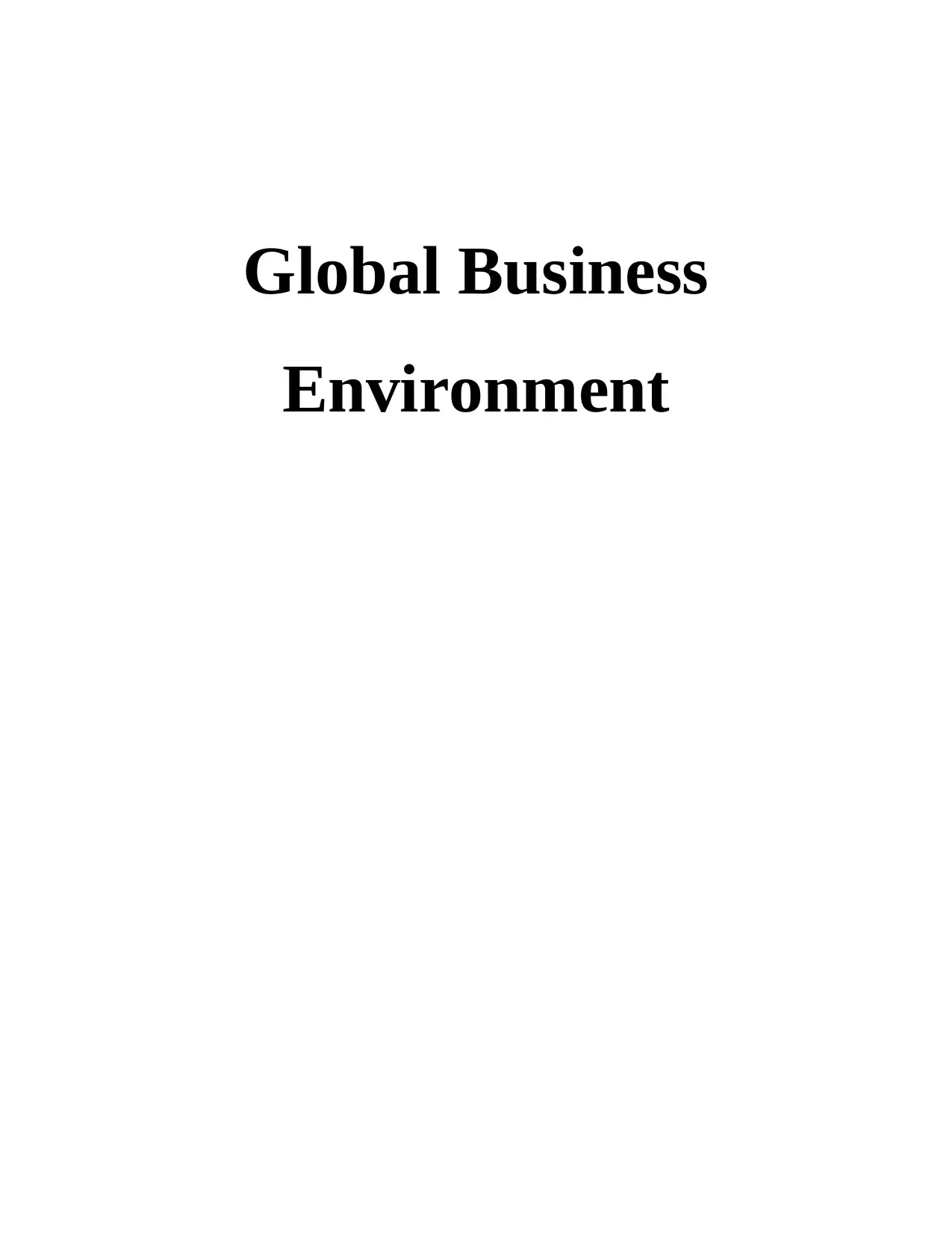
Global Business
Environment
Environment
Paraphrase This Document
Need a fresh take? Get an instant paraphrase of this document with our AI Paraphraser
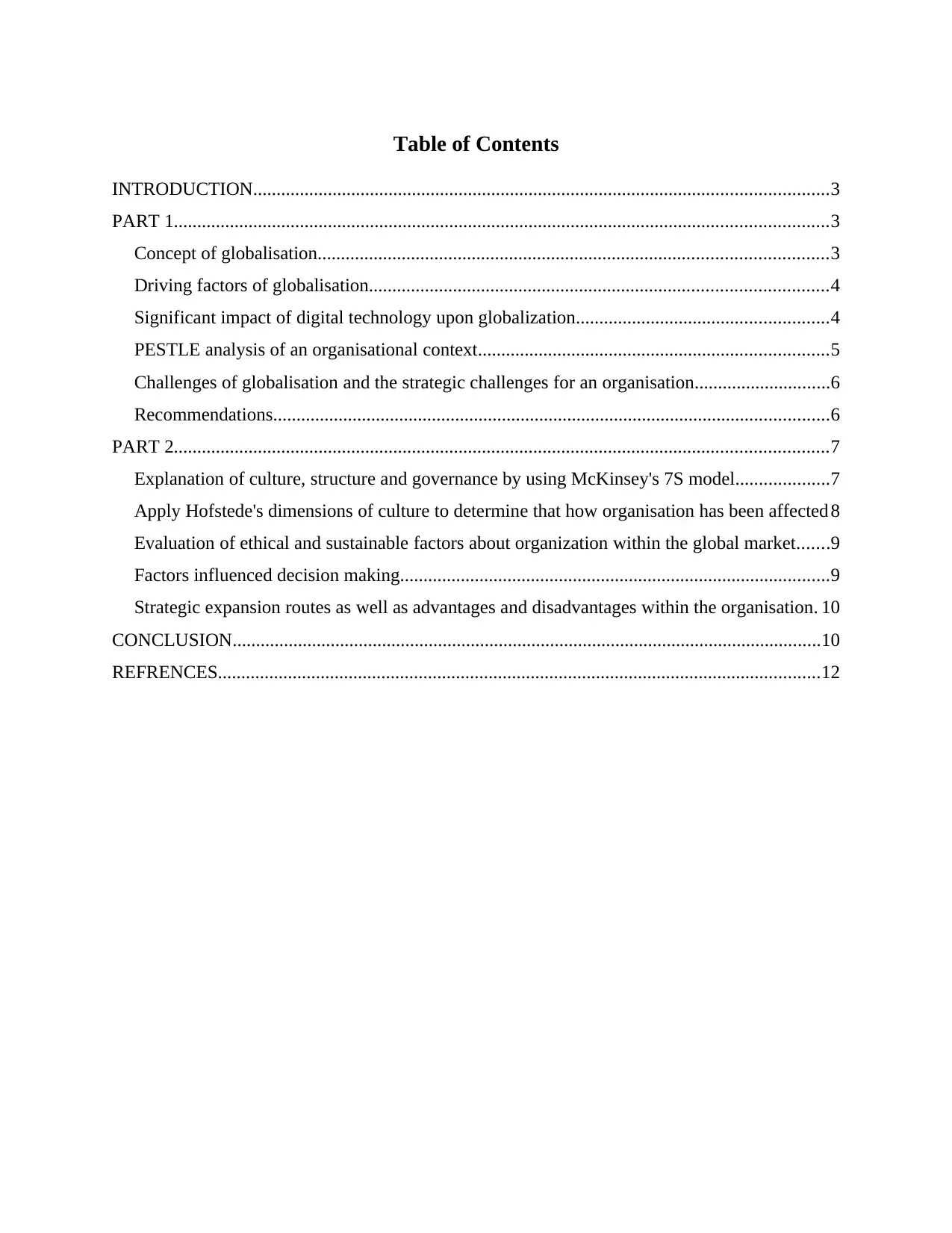
Table of Contents
INTRODUCTION...........................................................................................................................3
PART 1............................................................................................................................................3
Concept of globalisation.............................................................................................................3
Driving factors of globalisation..................................................................................................4
Significant impact of digital technology upon globalization......................................................4
PESTLE analysis of an organisational context...........................................................................5
Challenges of globalisation and the strategic challenges for an organisation.............................6
Recommendations.......................................................................................................................6
PART 2............................................................................................................................................7
Explanation of culture, structure and governance by using McKinsey's 7S model....................7
Apply Hofstede's dimensions of culture to determine that how organisation has been affected 8
Evaluation of ethical and sustainable factors about organization within the global market.......9
Factors influenced decision making............................................................................................9
Strategic expansion routes as well as advantages and disadvantages within the organisation. 10
CONCLUSION..............................................................................................................................10
REFRENCES.................................................................................................................................12
INTRODUCTION...........................................................................................................................3
PART 1............................................................................................................................................3
Concept of globalisation.............................................................................................................3
Driving factors of globalisation..................................................................................................4
Significant impact of digital technology upon globalization......................................................4
PESTLE analysis of an organisational context...........................................................................5
Challenges of globalisation and the strategic challenges for an organisation.............................6
Recommendations.......................................................................................................................6
PART 2............................................................................................................................................7
Explanation of culture, structure and governance by using McKinsey's 7S model....................7
Apply Hofstede's dimensions of culture to determine that how organisation has been affected 8
Evaluation of ethical and sustainable factors about organization within the global market.......9
Factors influenced decision making............................................................................................9
Strategic expansion routes as well as advantages and disadvantages within the organisation. 10
CONCLUSION..............................................................................................................................10
REFRENCES.................................................................................................................................12
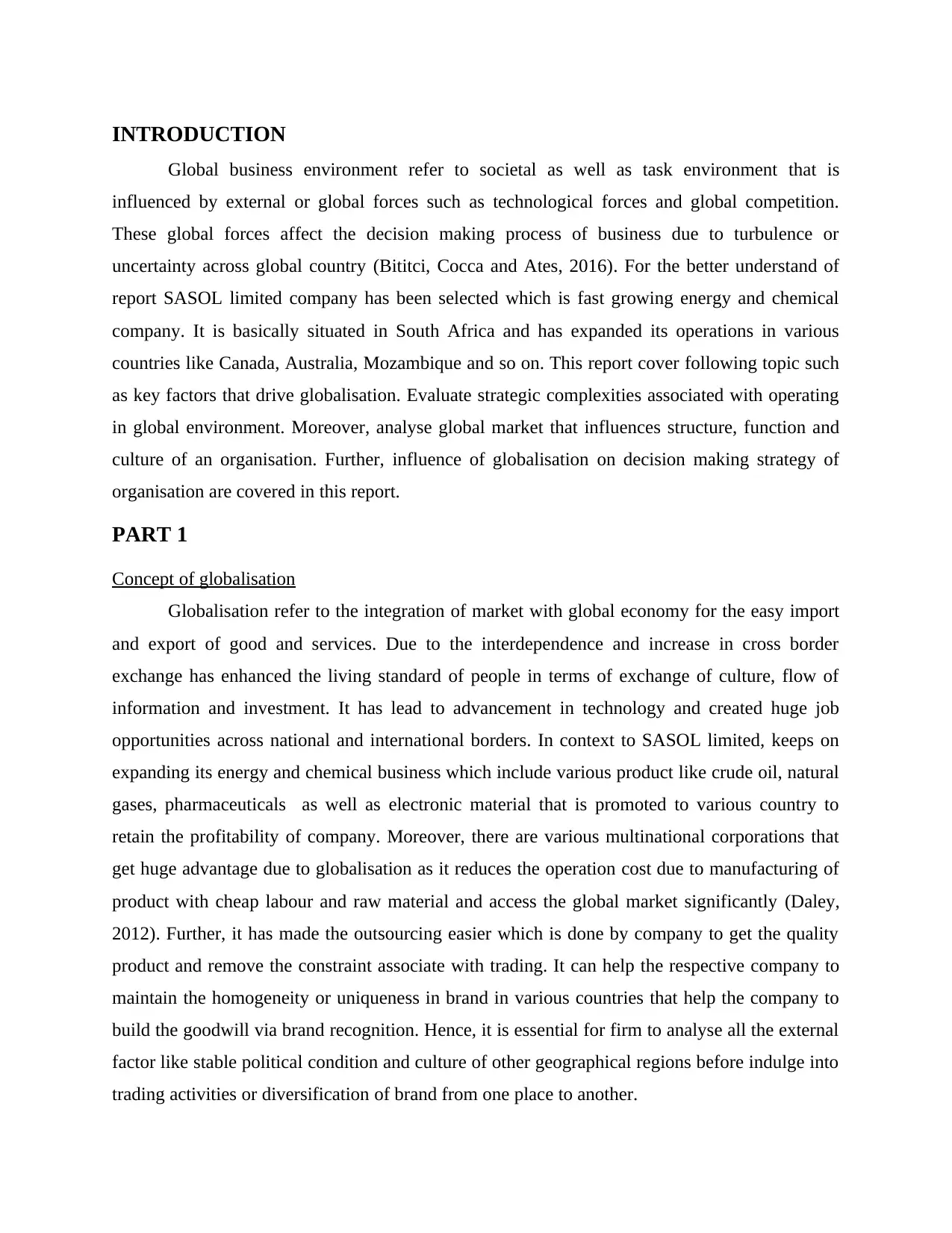
INTRODUCTION
Global business environment refer to societal as well as task environment that is
influenced by external or global forces such as technological forces and global competition.
These global forces affect the decision making process of business due to turbulence or
uncertainty across global country (Bititci, Cocca and Ates, 2016). For the better understand of
report SASOL limited company has been selected which is fast growing energy and chemical
company. It is basically situated in South Africa and has expanded its operations in various
countries like Canada, Australia, Mozambique and so on. This report cover following topic such
as key factors that drive globalisation. Evaluate strategic complexities associated with operating
in global environment. Moreover, analyse global market that influences structure, function and
culture of an organisation. Further, influence of globalisation on decision making strategy of
organisation are covered in this report.
PART 1
Concept of globalisation
Globalisation refer to the integration of market with global economy for the easy import
and export of good and services. Due to the interdependence and increase in cross border
exchange has enhanced the living standard of people in terms of exchange of culture, flow of
information and investment. It has lead to advancement in technology and created huge job
opportunities across national and international borders. In context to SASOL limited, keeps on
expanding its energy and chemical business which include various product like crude oil, natural
gases, pharmaceuticals as well as electronic material that is promoted to various country to
retain the profitability of company. Moreover, there are various multinational corporations that
get huge advantage due to globalisation as it reduces the operation cost due to manufacturing of
product with cheap labour and raw material and access the global market significantly (Daley,
2012). Further, it has made the outsourcing easier which is done by company to get the quality
product and remove the constraint associate with trading. It can help the respective company to
maintain the homogeneity or uniqueness in brand in various countries that help the company to
build the goodwill via brand recognition. Hence, it is essential for firm to analyse all the external
factor like stable political condition and culture of other geographical regions before indulge into
trading activities or diversification of brand from one place to another.
Global business environment refer to societal as well as task environment that is
influenced by external or global forces such as technological forces and global competition.
These global forces affect the decision making process of business due to turbulence or
uncertainty across global country (Bititci, Cocca and Ates, 2016). For the better understand of
report SASOL limited company has been selected which is fast growing energy and chemical
company. It is basically situated in South Africa and has expanded its operations in various
countries like Canada, Australia, Mozambique and so on. This report cover following topic such
as key factors that drive globalisation. Evaluate strategic complexities associated with operating
in global environment. Moreover, analyse global market that influences structure, function and
culture of an organisation. Further, influence of globalisation on decision making strategy of
organisation are covered in this report.
PART 1
Concept of globalisation
Globalisation refer to the integration of market with global economy for the easy import
and export of good and services. Due to the interdependence and increase in cross border
exchange has enhanced the living standard of people in terms of exchange of culture, flow of
information and investment. It has lead to advancement in technology and created huge job
opportunities across national and international borders. In context to SASOL limited, keeps on
expanding its energy and chemical business which include various product like crude oil, natural
gases, pharmaceuticals as well as electronic material that is promoted to various country to
retain the profitability of company. Moreover, there are various multinational corporations that
get huge advantage due to globalisation as it reduces the operation cost due to manufacturing of
product with cheap labour and raw material and access the global market significantly (Daley,
2012). Further, it has made the outsourcing easier which is done by company to get the quality
product and remove the constraint associate with trading. It can help the respective company to
maintain the homogeneity or uniqueness in brand in various countries that help the company to
build the goodwill via brand recognition. Hence, it is essential for firm to analyse all the external
factor like stable political condition and culture of other geographical regions before indulge into
trading activities or diversification of brand from one place to another.
⊘ This is a preview!⊘
Do you want full access?
Subscribe today to unlock all pages.

Trusted by 1+ million students worldwide
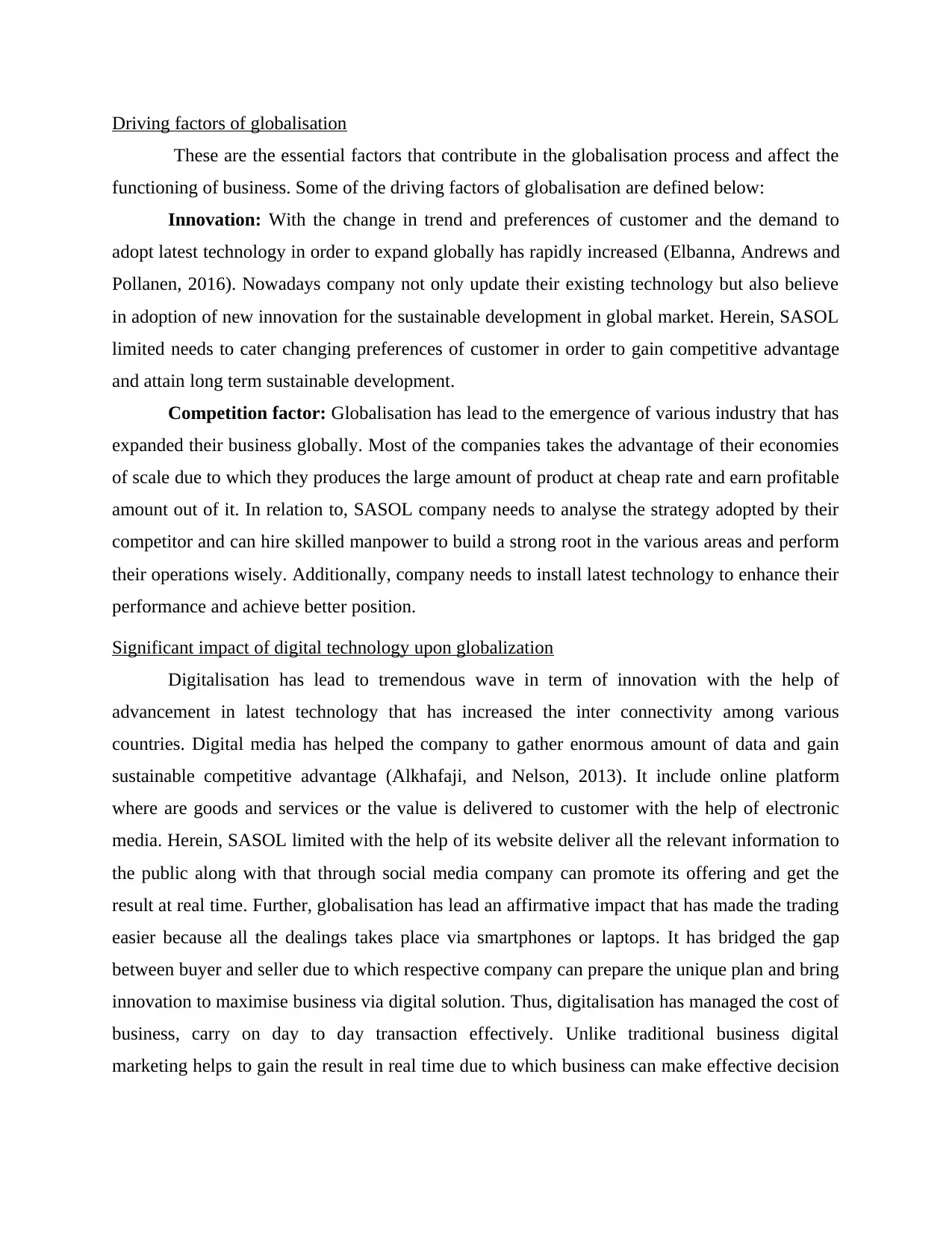
Driving factors of globalisation
These are the essential factors that contribute in the globalisation process and affect the
functioning of business. Some of the driving factors of globalisation are defined below:
Innovation: With the change in trend and preferences of customer and the demand to
adopt latest technology in order to expand globally has rapidly increased (Elbanna, Andrews and
Pollanen, 2016). Nowadays company not only update their existing technology but also believe
in adoption of new innovation for the sustainable development in global market. Herein, SASOL
limited needs to cater changing preferences of customer in order to gain competitive advantage
and attain long term sustainable development.
Competition factor: Globalisation has lead to the emergence of various industry that has
expanded their business globally. Most of the companies takes the advantage of their economies
of scale due to which they produces the large amount of product at cheap rate and earn profitable
amount out of it. In relation to, SASOL company needs to analyse the strategy adopted by their
competitor and can hire skilled manpower to build a strong root in the various areas and perform
their operations wisely. Additionally, company needs to install latest technology to enhance their
performance and achieve better position.
Significant impact of digital technology upon globalization
Digitalisation has lead to tremendous wave in term of innovation with the help of
advancement in latest technology that has increased the inter connectivity among various
countries. Digital media has helped the company to gather enormous amount of data and gain
sustainable competitive advantage (Alkhafaji, and Nelson, 2013). It include online platform
where are goods and services or the value is delivered to customer with the help of electronic
media. Herein, SASOL limited with the help of its website deliver all the relevant information to
the public along with that through social media company can promote its offering and get the
result at real time. Further, globalisation has lead an affirmative impact that has made the trading
easier because all the dealings takes place via smartphones or laptops. It has bridged the gap
between buyer and seller due to which respective company can prepare the unique plan and bring
innovation to maximise business via digital solution. Thus, digitalisation has managed the cost of
business, carry on day to day transaction effectively. Unlike traditional business digital
marketing helps to gain the result in real time due to which business can make effective decision
These are the essential factors that contribute in the globalisation process and affect the
functioning of business. Some of the driving factors of globalisation are defined below:
Innovation: With the change in trend and preferences of customer and the demand to
adopt latest technology in order to expand globally has rapidly increased (Elbanna, Andrews and
Pollanen, 2016). Nowadays company not only update their existing technology but also believe
in adoption of new innovation for the sustainable development in global market. Herein, SASOL
limited needs to cater changing preferences of customer in order to gain competitive advantage
and attain long term sustainable development.
Competition factor: Globalisation has lead to the emergence of various industry that has
expanded their business globally. Most of the companies takes the advantage of their economies
of scale due to which they produces the large amount of product at cheap rate and earn profitable
amount out of it. In relation to, SASOL company needs to analyse the strategy adopted by their
competitor and can hire skilled manpower to build a strong root in the various areas and perform
their operations wisely. Additionally, company needs to install latest technology to enhance their
performance and achieve better position.
Significant impact of digital technology upon globalization
Digitalisation has lead to tremendous wave in term of innovation with the help of
advancement in latest technology that has increased the inter connectivity among various
countries. Digital media has helped the company to gather enormous amount of data and gain
sustainable competitive advantage (Alkhafaji, and Nelson, 2013). It include online platform
where are goods and services or the value is delivered to customer with the help of electronic
media. Herein, SASOL limited with the help of its website deliver all the relevant information to
the public along with that through social media company can promote its offering and get the
result at real time. Further, globalisation has lead an affirmative impact that has made the trading
easier because all the dealings takes place via smartphones or laptops. It has bridged the gap
between buyer and seller due to which respective company can prepare the unique plan and bring
innovation to maximise business via digital solution. Thus, digitalisation has managed the cost of
business, carry on day to day transaction effectively. Unlike traditional business digital
marketing helps to gain the result in real time due to which business can make effective decision
Paraphrase This Document
Need a fresh take? Get an instant paraphrase of this document with our AI Paraphraser
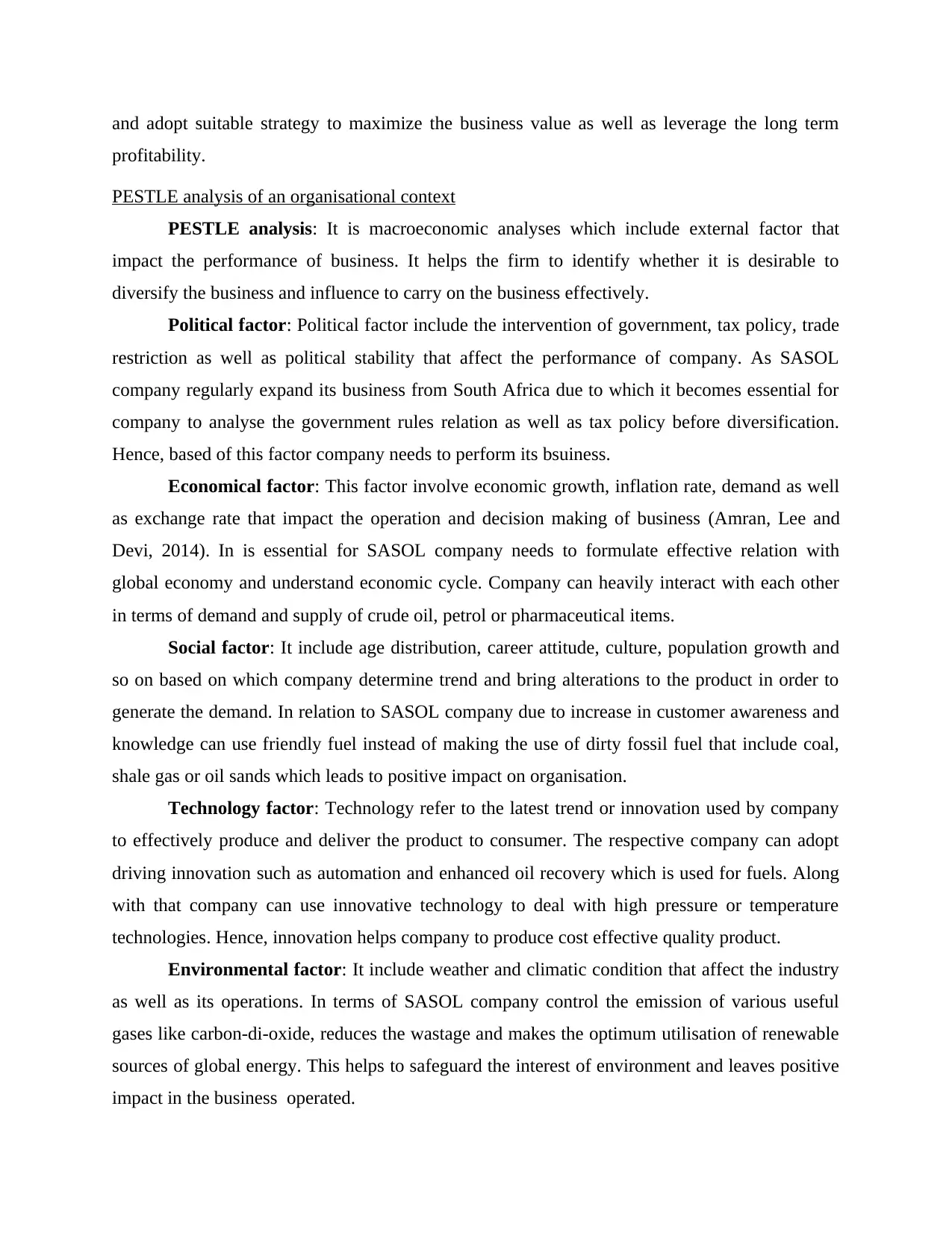
and adopt suitable strategy to maximize the business value as well as leverage the long term
profitability.
PESTLE analysis of an organisational context
PESTLE analysis: It is macroeconomic analyses which include external factor that
impact the performance of business. It helps the firm to identify whether it is desirable to
diversify the business and influence to carry on the business effectively.
Political factor: Political factor include the intervention of government, tax policy, trade
restriction as well as political stability that affect the performance of company. As SASOL
company regularly expand its business from South Africa due to which it becomes essential for
company to analyse the government rules relation as well as tax policy before diversification.
Hence, based of this factor company needs to perform its bsuiness.
Economical factor: This factor involve economic growth, inflation rate, demand as well
as exchange rate that impact the operation and decision making of business (Amran, Lee and
Devi, 2014). In is essential for SASOL company needs to formulate effective relation with
global economy and understand economic cycle. Company can heavily interact with each other
in terms of demand and supply of crude oil, petrol or pharmaceutical items.
Social factor: It include age distribution, career attitude, culture, population growth and
so on based on which company determine trend and bring alterations to the product in order to
generate the demand. In relation to SASOL company due to increase in customer awareness and
knowledge can use friendly fuel instead of making the use of dirty fossil fuel that include coal,
shale gas or oil sands which leads to positive impact on organisation.
Technology factor: Technology refer to the latest trend or innovation used by company
to effectively produce and deliver the product to consumer. The respective company can adopt
driving innovation such as automation and enhanced oil recovery which is used for fuels. Along
with that company can use innovative technology to deal with high pressure or temperature
technologies. Hence, innovation helps company to produce cost effective quality product.
Environmental factor: It include weather and climatic condition that affect the industry
as well as its operations. In terms of SASOL company control the emission of various useful
gases like carbon-di-oxide, reduces the wastage and makes the optimum utilisation of renewable
sources of global energy. This helps to safeguard the interest of environment and leaves positive
impact in the business operated.
profitability.
PESTLE analysis of an organisational context
PESTLE analysis: It is macroeconomic analyses which include external factor that
impact the performance of business. It helps the firm to identify whether it is desirable to
diversify the business and influence to carry on the business effectively.
Political factor: Political factor include the intervention of government, tax policy, trade
restriction as well as political stability that affect the performance of company. As SASOL
company regularly expand its business from South Africa due to which it becomes essential for
company to analyse the government rules relation as well as tax policy before diversification.
Hence, based of this factor company needs to perform its bsuiness.
Economical factor: This factor involve economic growth, inflation rate, demand as well
as exchange rate that impact the operation and decision making of business (Amran, Lee and
Devi, 2014). In is essential for SASOL company needs to formulate effective relation with
global economy and understand economic cycle. Company can heavily interact with each other
in terms of demand and supply of crude oil, petrol or pharmaceutical items.
Social factor: It include age distribution, career attitude, culture, population growth and
so on based on which company determine trend and bring alterations to the product in order to
generate the demand. In relation to SASOL company due to increase in customer awareness and
knowledge can use friendly fuel instead of making the use of dirty fossil fuel that include coal,
shale gas or oil sands which leads to positive impact on organisation.
Technology factor: Technology refer to the latest trend or innovation used by company
to effectively produce and deliver the product to consumer. The respective company can adopt
driving innovation such as automation and enhanced oil recovery which is used for fuels. Along
with that company can use innovative technology to deal with high pressure or temperature
technologies. Hence, innovation helps company to produce cost effective quality product.
Environmental factor: It include weather and climatic condition that affect the industry
as well as its operations. In terms of SASOL company control the emission of various useful
gases like carbon-di-oxide, reduces the wastage and makes the optimum utilisation of renewable
sources of global energy. This helps to safeguard the interest of environment and leaves positive
impact in the business operated.
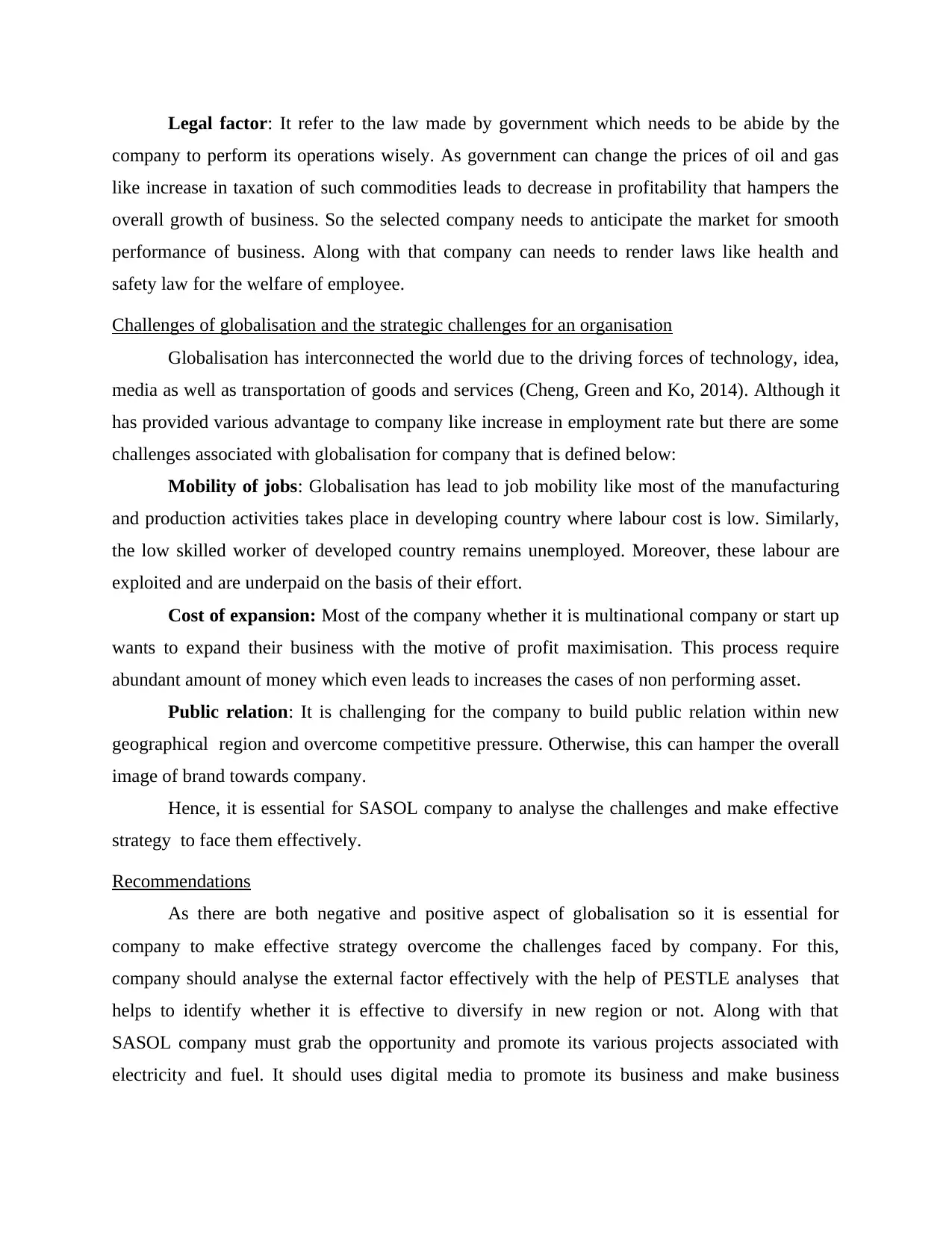
Legal factor: It refer to the law made by government which needs to be abide by the
company to perform its operations wisely. As government can change the prices of oil and gas
like increase in taxation of such commodities leads to decrease in profitability that hampers the
overall growth of business. So the selected company needs to anticipate the market for smooth
performance of business. Along with that company can needs to render laws like health and
safety law for the welfare of employee.
Challenges of globalisation and the strategic challenges for an organisation
Globalisation has interconnected the world due to the driving forces of technology, idea,
media as well as transportation of goods and services (Cheng, Green and Ko, 2014). Although it
has provided various advantage to company like increase in employment rate but there are some
challenges associated with globalisation for company that is defined below:
Mobility of jobs: Globalisation has lead to job mobility like most of the manufacturing
and production activities takes place in developing country where labour cost is low. Similarly,
the low skilled worker of developed country remains unemployed. Moreover, these labour are
exploited and are underpaid on the basis of their effort.
Cost of expansion: Most of the company whether it is multinational company or start up
wants to expand their business with the motive of profit maximisation. This process require
abundant amount of money which even leads to increases the cases of non performing asset.
Public relation: It is challenging for the company to build public relation within new
geographical region and overcome competitive pressure. Otherwise, this can hamper the overall
image of brand towards company.
Hence, it is essential for SASOL company to analyse the challenges and make effective
strategy to face them effectively.
Recommendations
As there are both negative and positive aspect of globalisation so it is essential for
company to make effective strategy overcome the challenges faced by company. For this,
company should analyse the external factor effectively with the help of PESTLE analyses that
helps to identify whether it is effective to diversify in new region or not. Along with that
SASOL company must grab the opportunity and promote its various projects associated with
electricity and fuel. It should uses digital media to promote its business and make business
company to perform its operations wisely. As government can change the prices of oil and gas
like increase in taxation of such commodities leads to decrease in profitability that hampers the
overall growth of business. So the selected company needs to anticipate the market for smooth
performance of business. Along with that company can needs to render laws like health and
safety law for the welfare of employee.
Challenges of globalisation and the strategic challenges for an organisation
Globalisation has interconnected the world due to the driving forces of technology, idea,
media as well as transportation of goods and services (Cheng, Green and Ko, 2014). Although it
has provided various advantage to company like increase in employment rate but there are some
challenges associated with globalisation for company that is defined below:
Mobility of jobs: Globalisation has lead to job mobility like most of the manufacturing
and production activities takes place in developing country where labour cost is low. Similarly,
the low skilled worker of developed country remains unemployed. Moreover, these labour are
exploited and are underpaid on the basis of their effort.
Cost of expansion: Most of the company whether it is multinational company or start up
wants to expand their business with the motive of profit maximisation. This process require
abundant amount of money which even leads to increases the cases of non performing asset.
Public relation: It is challenging for the company to build public relation within new
geographical region and overcome competitive pressure. Otherwise, this can hamper the overall
image of brand towards company.
Hence, it is essential for SASOL company to analyse the challenges and make effective
strategy to face them effectively.
Recommendations
As there are both negative and positive aspect of globalisation so it is essential for
company to make effective strategy overcome the challenges faced by company. For this,
company should analyse the external factor effectively with the help of PESTLE analyses that
helps to identify whether it is effective to diversify in new region or not. Along with that
SASOL company must grab the opportunity and promote its various projects associated with
electricity and fuel. It should uses digital media to promote its business and make business
⊘ This is a preview!⊘
Do you want full access?
Subscribe today to unlock all pages.

Trusted by 1+ million students worldwide
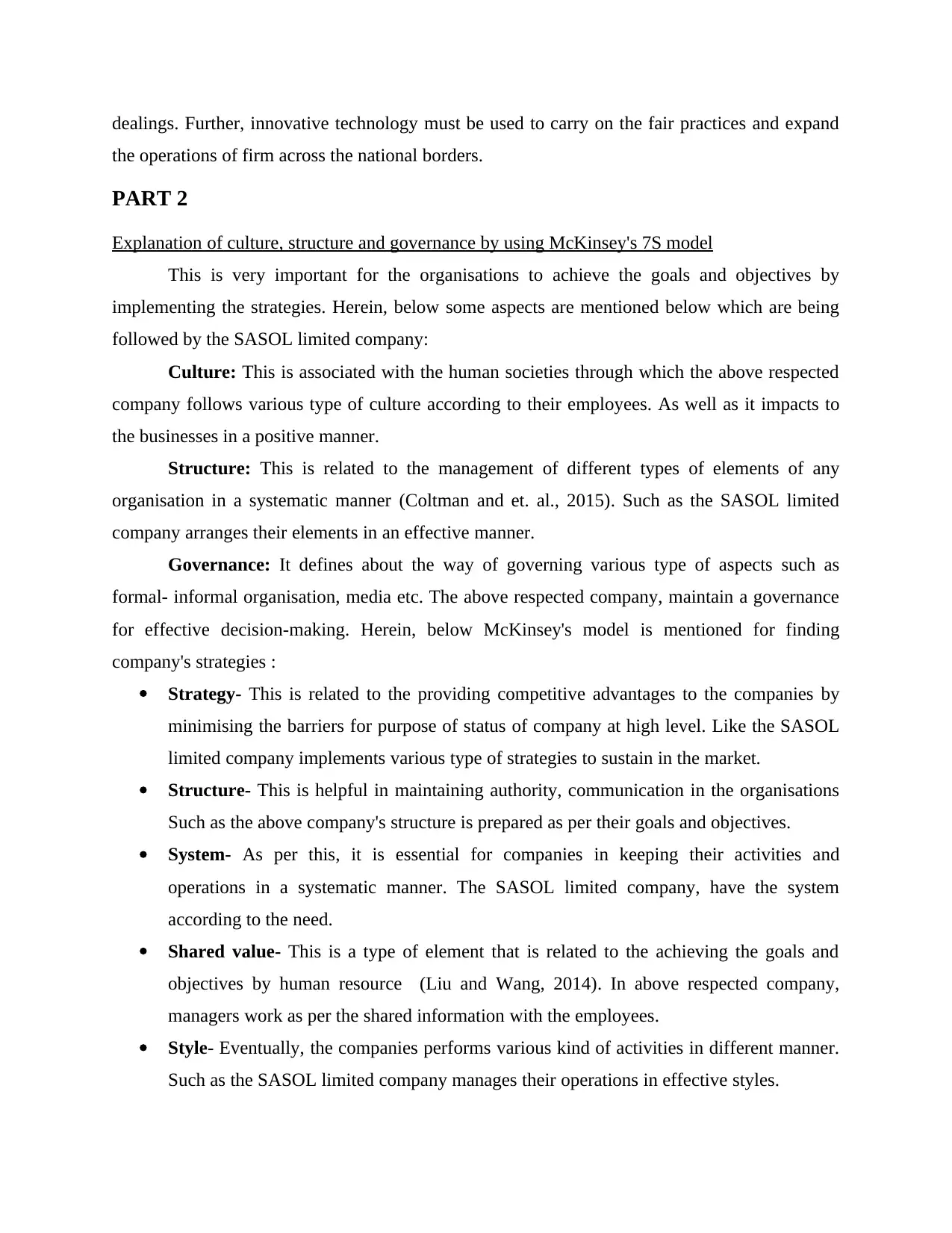
dealings. Further, innovative technology must be used to carry on the fair practices and expand
the operations of firm across the national borders.
PART 2
Explanation of culture, structure and governance by using McKinsey's 7S model
This is very important for the organisations to achieve the goals and objectives by
implementing the strategies. Herein, below some aspects are mentioned below which are being
followed by the SASOL limited company:
Culture: This is associated with the human societies through which the above respected
company follows various type of culture according to their employees. As well as it impacts to
the businesses in a positive manner.
Structure: This is related to the management of different types of elements of any
organisation in a systematic manner (Coltman and et. al., 2015). Such as the SASOL limited
company arranges their elements in an effective manner.
Governance: It defines about the way of governing various type of aspects such as
formal- informal organisation, media etc. The above respected company, maintain a governance
for effective decision-making. Herein, below McKinsey's model is mentioned for finding
company's strategies :
Strategy- This is related to the providing competitive advantages to the companies by
minimising the barriers for purpose of status of company at high level. Like the SASOL
limited company implements various type of strategies to sustain in the market.
Structure- This is helpful in maintaining authority, communication in the organisations
Such as the above company's structure is prepared as per their goals and objectives.
System- As per this, it is essential for companies in keeping their activities and
operations in a systematic manner. The SASOL limited company, have the system
according to the need.
Shared value- This is a type of element that is related to the achieving the goals and
objectives by human resource (Liu and Wang, 2014). In above respected company,
managers work as per the shared information with the employees.
Style- Eventually, the companies performs various kind of activities in different manner.
Such as the SASOL limited company manages their operations in effective styles.
the operations of firm across the national borders.
PART 2
Explanation of culture, structure and governance by using McKinsey's 7S model
This is very important for the organisations to achieve the goals and objectives by
implementing the strategies. Herein, below some aspects are mentioned below which are being
followed by the SASOL limited company:
Culture: This is associated with the human societies through which the above respected
company follows various type of culture according to their employees. As well as it impacts to
the businesses in a positive manner.
Structure: This is related to the management of different types of elements of any
organisation in a systematic manner (Coltman and et. al., 2015). Such as the SASOL limited
company arranges their elements in an effective manner.
Governance: It defines about the way of governing various type of aspects such as
formal- informal organisation, media etc. The above respected company, maintain a governance
for effective decision-making. Herein, below McKinsey's model is mentioned for finding
company's strategies :
Strategy- This is related to the providing competitive advantages to the companies by
minimising the barriers for purpose of status of company at high level. Like the SASOL
limited company implements various type of strategies to sustain in the market.
Structure- This is helpful in maintaining authority, communication in the organisations
Such as the above company's structure is prepared as per their goals and objectives.
System- As per this, it is essential for companies in keeping their activities and
operations in a systematic manner. The SASOL limited company, have the system
according to the need.
Shared value- This is a type of element that is related to the achieving the goals and
objectives by human resource (Liu and Wang, 2014). In above respected company,
managers work as per the shared information with the employees.
Style- Eventually, the companies performs various kind of activities in different manner.
Such as the SASOL limited company manages their operations in effective styles.
Paraphrase This Document
Need a fresh take? Get an instant paraphrase of this document with our AI Paraphraser
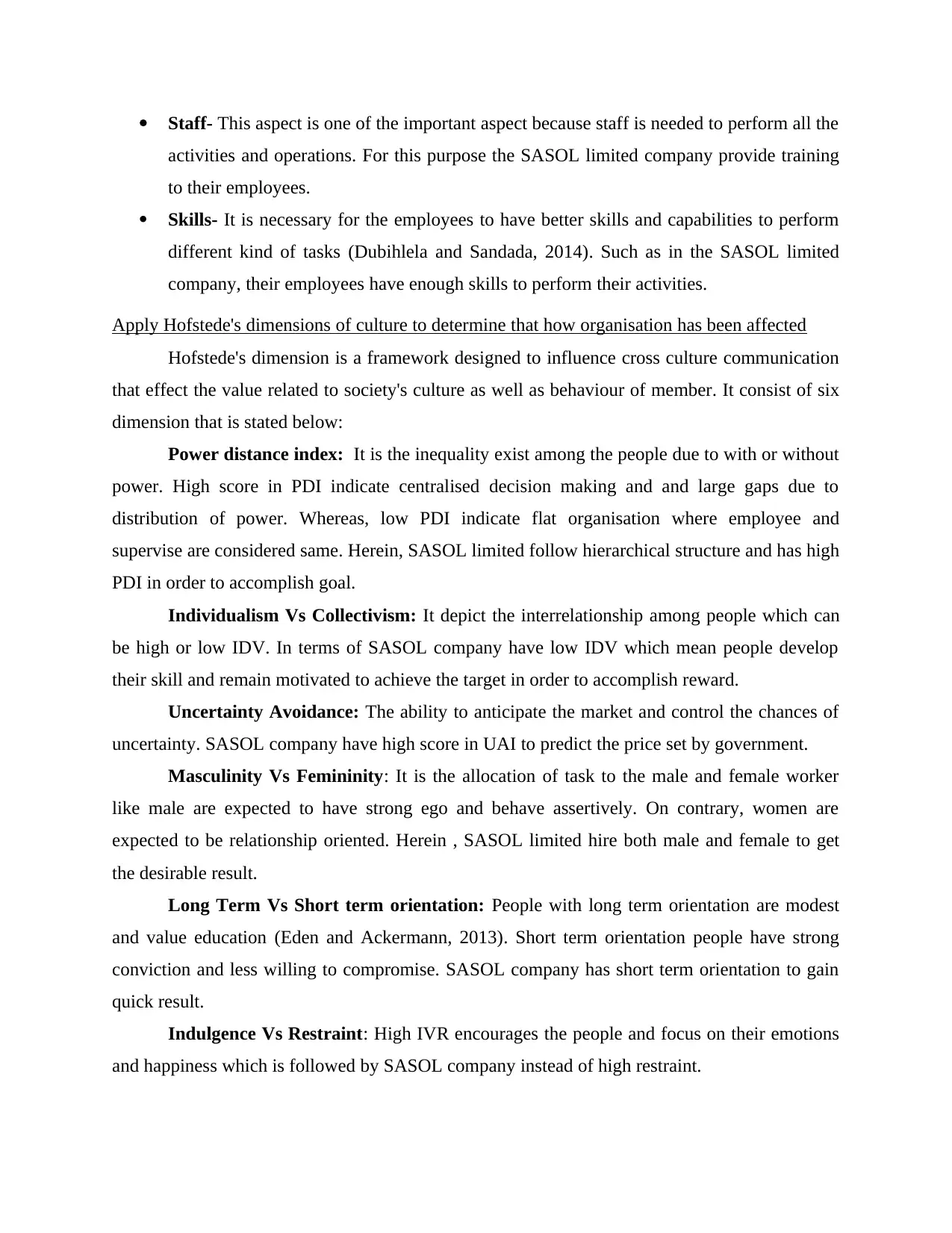
Staff- This aspect is one of the important aspect because staff is needed to perform all the
activities and operations. For this purpose the SASOL limited company provide training
to their employees.
Skills- It is necessary for the employees to have better skills and capabilities to perform
different kind of tasks (Dubihlela and Sandada, 2014). Such as in the SASOL limited
company, their employees have enough skills to perform their activities.
Apply Hofstede's dimensions of culture to determine that how organisation has been affected
Hofstede's dimension is a framework designed to influence cross culture communication
that effect the value related to society's culture as well as behaviour of member. It consist of six
dimension that is stated below:
Power distance index: It is the inequality exist among the people due to with or without
power. High score in PDI indicate centralised decision making and and large gaps due to
distribution of power. Whereas, low PDI indicate flat organisation where employee and
supervise are considered same. Herein, SASOL limited follow hierarchical structure and has high
PDI in order to accomplish goal.
Individualism Vs Collectivism: It depict the interrelationship among people which can
be high or low IDV. In terms of SASOL company have low IDV which mean people develop
their skill and remain motivated to achieve the target in order to accomplish reward.
Uncertainty Avoidance: The ability to anticipate the market and control the chances of
uncertainty. SASOL company have high score in UAI to predict the price set by government.
Masculinity Vs Femininity: It is the allocation of task to the male and female worker
like male are expected to have strong ego and behave assertively. On contrary, women are
expected to be relationship oriented. Herein , SASOL limited hire both male and female to get
the desirable result.
Long Term Vs Short term orientation: People with long term orientation are modest
and value education (Eden and Ackermann, 2013). Short term orientation people have strong
conviction and less willing to compromise. SASOL company has short term orientation to gain
quick result.
Indulgence Vs Restraint: High IVR encourages the people and focus on their emotions
and happiness which is followed by SASOL company instead of high restraint.
activities and operations. For this purpose the SASOL limited company provide training
to their employees.
Skills- It is necessary for the employees to have better skills and capabilities to perform
different kind of tasks (Dubihlela and Sandada, 2014). Such as in the SASOL limited
company, their employees have enough skills to perform their activities.
Apply Hofstede's dimensions of culture to determine that how organisation has been affected
Hofstede's dimension is a framework designed to influence cross culture communication
that effect the value related to society's culture as well as behaviour of member. It consist of six
dimension that is stated below:
Power distance index: It is the inequality exist among the people due to with or without
power. High score in PDI indicate centralised decision making and and large gaps due to
distribution of power. Whereas, low PDI indicate flat organisation where employee and
supervise are considered same. Herein, SASOL limited follow hierarchical structure and has high
PDI in order to accomplish goal.
Individualism Vs Collectivism: It depict the interrelationship among people which can
be high or low IDV. In terms of SASOL company have low IDV which mean people develop
their skill and remain motivated to achieve the target in order to accomplish reward.
Uncertainty Avoidance: The ability to anticipate the market and control the chances of
uncertainty. SASOL company have high score in UAI to predict the price set by government.
Masculinity Vs Femininity: It is the allocation of task to the male and female worker
like male are expected to have strong ego and behave assertively. On contrary, women are
expected to be relationship oriented. Herein , SASOL limited hire both male and female to get
the desirable result.
Long Term Vs Short term orientation: People with long term orientation are modest
and value education (Eden and Ackermann, 2013). Short term orientation people have strong
conviction and less willing to compromise. SASOL company has short term orientation to gain
quick result.
Indulgence Vs Restraint: High IVR encourages the people and focus on their emotions
and happiness which is followed by SASOL company instead of high restraint.
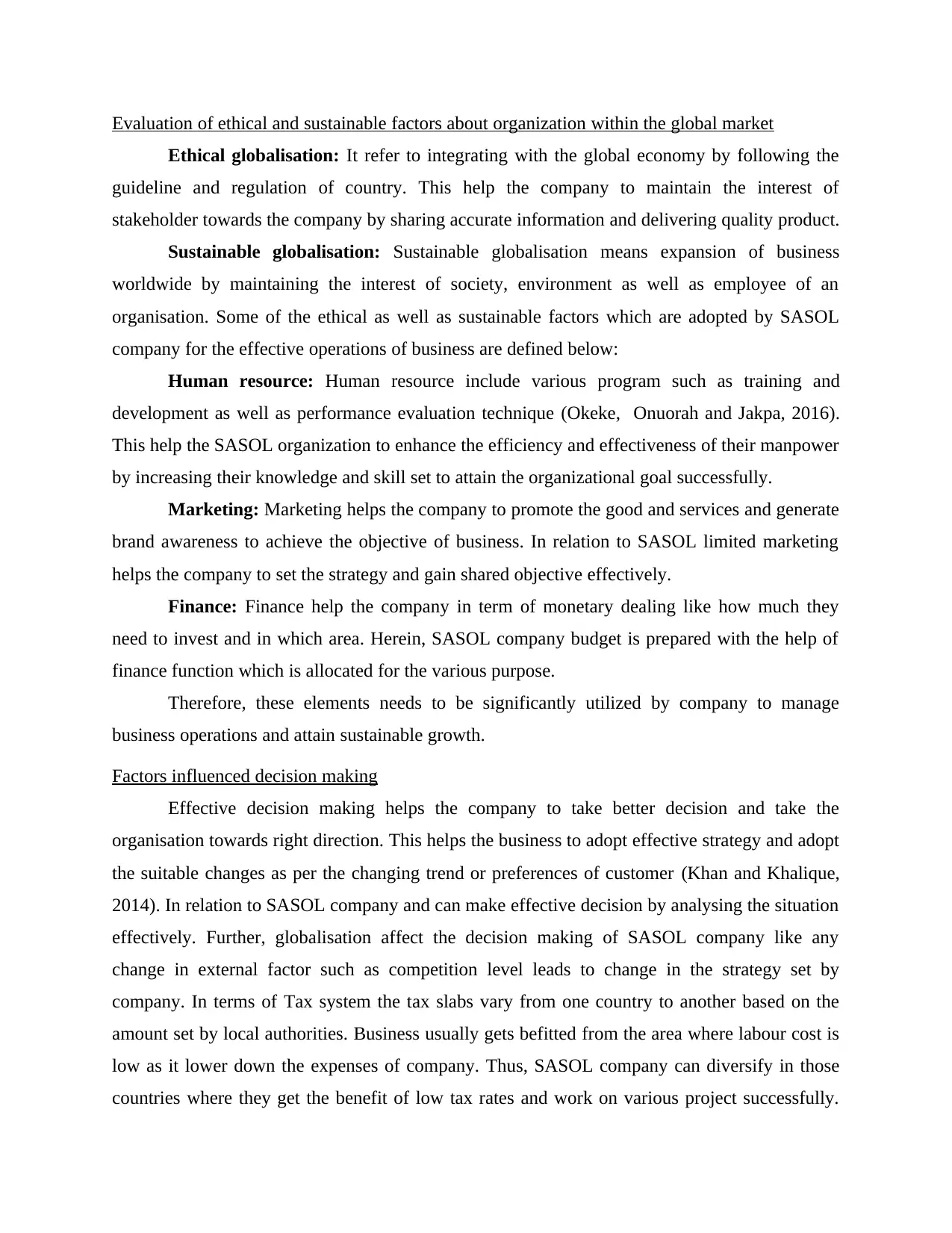
Evaluation of ethical and sustainable factors about organization within the global market
Ethical globalisation: It refer to integrating with the global economy by following the
guideline and regulation of country. This help the company to maintain the interest of
stakeholder towards the company by sharing accurate information and delivering quality product.
Sustainable globalisation: Sustainable globalisation means expansion of business
worldwide by maintaining the interest of society, environment as well as employee of an
organisation. Some of the ethical as well as sustainable factors which are adopted by SASOL
company for the effective operations of business are defined below:
Human resource: Human resource include various program such as training and
development as well as performance evaluation technique (Okeke, Onuorah and Jakpa, 2016).
This help the SASOL organization to enhance the efficiency and effectiveness of their manpower
by increasing their knowledge and skill set to attain the organizational goal successfully.
Marketing: Marketing helps the company to promote the good and services and generate
brand awareness to achieve the objective of business. In relation to SASOL limited marketing
helps the company to set the strategy and gain shared objective effectively.
Finance: Finance help the company in term of monetary dealing like how much they
need to invest and in which area. Herein, SASOL company budget is prepared with the help of
finance function which is allocated for the various purpose.
Therefore, these elements needs to be significantly utilized by company to manage
business operations and attain sustainable growth.
Factors influenced decision making
Effective decision making helps the company to take better decision and take the
organisation towards right direction. This helps the business to adopt effective strategy and adopt
the suitable changes as per the changing trend or preferences of customer (Khan and Khalique,
2014). In relation to SASOL company and can make effective decision by analysing the situation
effectively. Further, globalisation affect the decision making of SASOL company like any
change in external factor such as competition level leads to change in the strategy set by
company. In terms of Tax system the tax slabs vary from one country to another based on the
amount set by local authorities. Business usually gets befitted from the area where labour cost is
low as it lower down the expenses of company. Thus, SASOL company can diversify in those
countries where they get the benefit of low tax rates and work on various project successfully.
Ethical globalisation: It refer to integrating with the global economy by following the
guideline and regulation of country. This help the company to maintain the interest of
stakeholder towards the company by sharing accurate information and delivering quality product.
Sustainable globalisation: Sustainable globalisation means expansion of business
worldwide by maintaining the interest of society, environment as well as employee of an
organisation. Some of the ethical as well as sustainable factors which are adopted by SASOL
company for the effective operations of business are defined below:
Human resource: Human resource include various program such as training and
development as well as performance evaluation technique (Okeke, Onuorah and Jakpa, 2016).
This help the SASOL organization to enhance the efficiency and effectiveness of their manpower
by increasing their knowledge and skill set to attain the organizational goal successfully.
Marketing: Marketing helps the company to promote the good and services and generate
brand awareness to achieve the objective of business. In relation to SASOL limited marketing
helps the company to set the strategy and gain shared objective effectively.
Finance: Finance help the company in term of monetary dealing like how much they
need to invest and in which area. Herein, SASOL company budget is prepared with the help of
finance function which is allocated for the various purpose.
Therefore, these elements needs to be significantly utilized by company to manage
business operations and attain sustainable growth.
Factors influenced decision making
Effective decision making helps the company to take better decision and take the
organisation towards right direction. This helps the business to adopt effective strategy and adopt
the suitable changes as per the changing trend or preferences of customer (Khan and Khalique,
2014). In relation to SASOL company and can make effective decision by analysing the situation
effectively. Further, globalisation affect the decision making of SASOL company like any
change in external factor such as competition level leads to change in the strategy set by
company. In terms of Tax system the tax slabs vary from one country to another based on the
amount set by local authorities. Business usually gets befitted from the area where labour cost is
low as it lower down the expenses of company. Thus, SASOL company can diversify in those
countries where they get the benefit of low tax rates and work on various project successfully.
⊘ This is a preview!⊘
Do you want full access?
Subscribe today to unlock all pages.

Trusted by 1+ million students worldwide
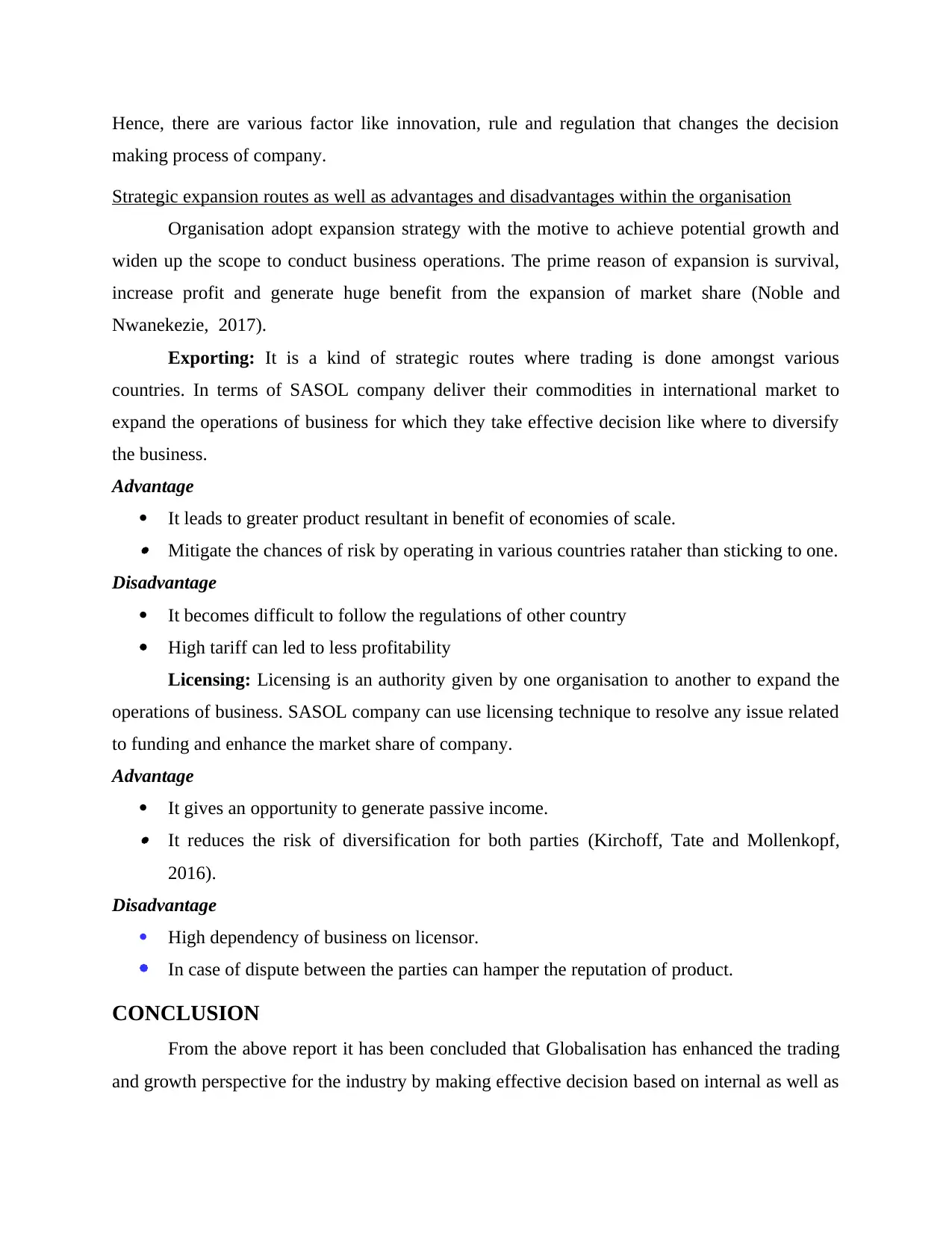
Hence, there are various factor like innovation, rule and regulation that changes the decision
making process of company.
Strategic expansion routes as well as advantages and disadvantages within the organisation
Organisation adopt expansion strategy with the motive to achieve potential growth and
widen up the scope to conduct business operations. The prime reason of expansion is survival,
increase profit and generate huge benefit from the expansion of market share (Noble and
Nwanekezie, 2017).
Exporting: It is a kind of strategic routes where trading is done amongst various
countries. In terms of SASOL company deliver their commodities in international market to
expand the operations of business for which they take effective decision like where to diversify
the business.
Advantage
It leads to greater product resultant in benefit of economies of scale. Mitigate the chances of risk by operating in various countries rataher than sticking to one.
Disadvantage
It becomes difficult to follow the regulations of other country
High tariff can led to less profitability
Licensing: Licensing is an authority given by one organisation to another to expand the
operations of business. SASOL company can use licensing technique to resolve any issue related
to funding and enhance the market share of company.
Advantage
It gives an opportunity to generate passive income. It reduces the risk of diversification for both parties (Kirchoff, Tate and Mollenkopf,
2016).
Disadvantage
High dependency of business on licensor.
In case of dispute between the parties can hamper the reputation of product.
CONCLUSION
From the above report it has been concluded that Globalisation has enhanced the trading
and growth perspective for the industry by making effective decision based on internal as well as
making process of company.
Strategic expansion routes as well as advantages and disadvantages within the organisation
Organisation adopt expansion strategy with the motive to achieve potential growth and
widen up the scope to conduct business operations. The prime reason of expansion is survival,
increase profit and generate huge benefit from the expansion of market share (Noble and
Nwanekezie, 2017).
Exporting: It is a kind of strategic routes where trading is done amongst various
countries. In terms of SASOL company deliver their commodities in international market to
expand the operations of business for which they take effective decision like where to diversify
the business.
Advantage
It leads to greater product resultant in benefit of economies of scale. Mitigate the chances of risk by operating in various countries rataher than sticking to one.
Disadvantage
It becomes difficult to follow the regulations of other country
High tariff can led to less profitability
Licensing: Licensing is an authority given by one organisation to another to expand the
operations of business. SASOL company can use licensing technique to resolve any issue related
to funding and enhance the market share of company.
Advantage
It gives an opportunity to generate passive income. It reduces the risk of diversification for both parties (Kirchoff, Tate and Mollenkopf,
2016).
Disadvantage
High dependency of business on licensor.
In case of dispute between the parties can hamper the reputation of product.
CONCLUSION
From the above report it has been concluded that Globalisation has enhanced the trading
and growth perspective for the industry by making effective decision based on internal as well as
Paraphrase This Document
Need a fresh take? Get an instant paraphrase of this document with our AI Paraphraser
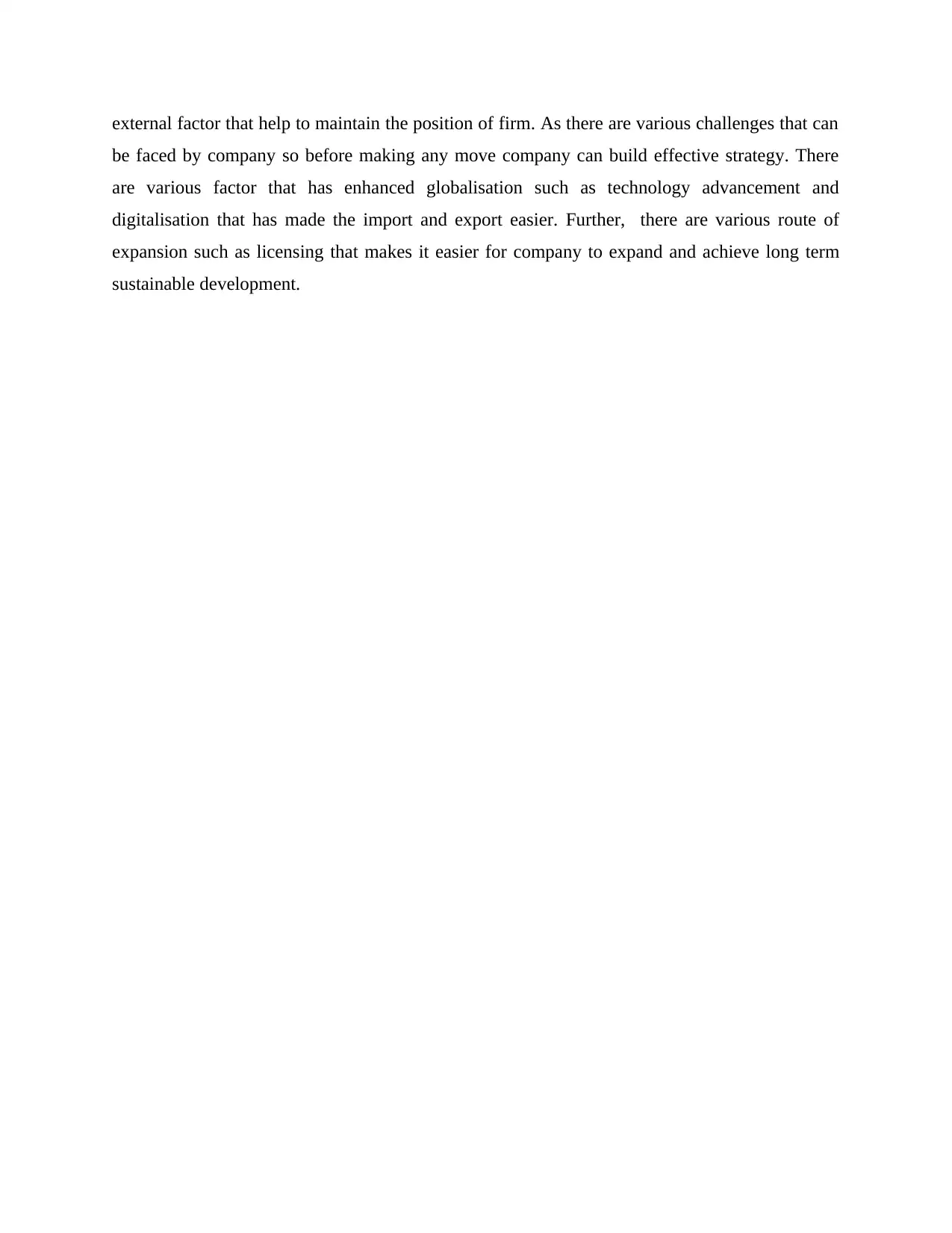
external factor that help to maintain the position of firm. As there are various challenges that can
be faced by company so before making any move company can build effective strategy. There
are various factor that has enhanced globalisation such as technology advancement and
digitalisation that has made the import and export easier. Further, there are various route of
expansion such as licensing that makes it easier for company to expand and achieve long term
sustainable development.
be faced by company so before making any move company can build effective strategy. There
are various factor that has enhanced globalisation such as technology advancement and
digitalisation that has made the import and export easier. Further, there are various route of
expansion such as licensing that makes it easier for company to expand and achieve long term
sustainable development.
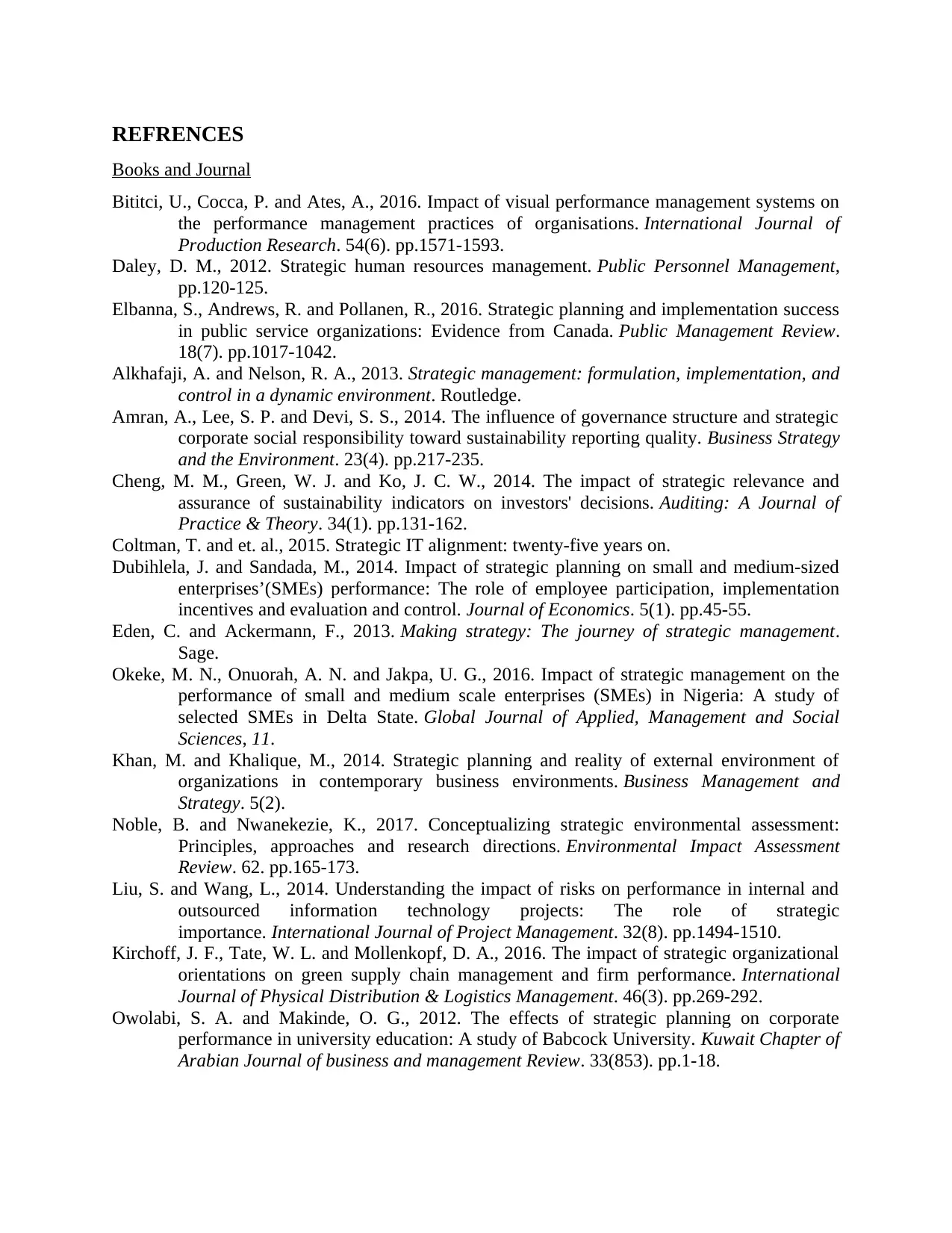
REFRENCES
Books and Journal
Bititci, U., Cocca, P. and Ates, A., 2016. Impact of visual performance management systems on
the performance management practices of organisations. International Journal of
Production Research. 54(6). pp.1571-1593.
Daley, D. M., 2012. Strategic human resources management. Public Personnel Management,
pp.120-125.
Elbanna, S., Andrews, R. and Pollanen, R., 2016. Strategic planning and implementation success
in public service organizations: Evidence from Canada. Public Management Review.
18(7). pp.1017-1042.
Alkhafaji, A. and Nelson, R. A., 2013. Strategic management: formulation, implementation, and
control in a dynamic environment. Routledge.
Amran, A., Lee, S. P. and Devi, S. S., 2014. The influence of governance structure and strategic
corporate social responsibility toward sustainability reporting quality. Business Strategy
and the Environment. 23(4). pp.217-235.
Cheng, M. M., Green, W. J. and Ko, J. C. W., 2014. The impact of strategic relevance and
assurance of sustainability indicators on investors' decisions. Auditing: A Journal of
Practice & Theory. 34(1). pp.131-162.
Coltman, T. and et. al., 2015. Strategic IT alignment: twenty-five years on.
Dubihlela, J. and Sandada, M., 2014. Impact of strategic planning on small and medium-sized
enterprises’(SMEs) performance: The role of employee participation, implementation
incentives and evaluation and control. Journal of Economics. 5(1). pp.45-55.
Eden, C. and Ackermann, F., 2013. Making strategy: The journey of strategic management.
Sage.
Okeke, M. N., Onuorah, A. N. and Jakpa, U. G., 2016. Impact of strategic management on the
performance of small and medium scale enterprises (SMEs) in Nigeria: A study of
selected SMEs in Delta State. Global Journal of Applied, Management and Social
Sciences, 11.
Khan, M. and Khalique, M., 2014. Strategic planning and reality of external environment of
organizations in contemporary business environments. Business Management and
Strategy. 5(2).
Noble, B. and Nwanekezie, K., 2017. Conceptualizing strategic environmental assessment:
Principles, approaches and research directions. Environmental Impact Assessment
Review. 62. pp.165-173.
Liu, S. and Wang, L., 2014. Understanding the impact of risks on performance in internal and
outsourced information technology projects: The role of strategic
importance. International Journal of Project Management. 32(8). pp.1494-1510.
Kirchoff, J. F., Tate, W. L. and Mollenkopf, D. A., 2016. The impact of strategic organizational
orientations on green supply chain management and firm performance. International
Journal of Physical Distribution & Logistics Management. 46(3). pp.269-292.
Owolabi, S. A. and Makinde, O. G., 2012. The effects of strategic planning on corporate
performance in university education: A study of Babcock University. Kuwait Chapter of
Arabian Journal of business and management Review. 33(853). pp.1-18.
Books and Journal
Bititci, U., Cocca, P. and Ates, A., 2016. Impact of visual performance management systems on
the performance management practices of organisations. International Journal of
Production Research. 54(6). pp.1571-1593.
Daley, D. M., 2012. Strategic human resources management. Public Personnel Management,
pp.120-125.
Elbanna, S., Andrews, R. and Pollanen, R., 2016. Strategic planning and implementation success
in public service organizations: Evidence from Canada. Public Management Review.
18(7). pp.1017-1042.
Alkhafaji, A. and Nelson, R. A., 2013. Strategic management: formulation, implementation, and
control in a dynamic environment. Routledge.
Amran, A., Lee, S. P. and Devi, S. S., 2014. The influence of governance structure and strategic
corporate social responsibility toward sustainability reporting quality. Business Strategy
and the Environment. 23(4). pp.217-235.
Cheng, M. M., Green, W. J. and Ko, J. C. W., 2014. The impact of strategic relevance and
assurance of sustainability indicators on investors' decisions. Auditing: A Journal of
Practice & Theory. 34(1). pp.131-162.
Coltman, T. and et. al., 2015. Strategic IT alignment: twenty-five years on.
Dubihlela, J. and Sandada, M., 2014. Impact of strategic planning on small and medium-sized
enterprises’(SMEs) performance: The role of employee participation, implementation
incentives and evaluation and control. Journal of Economics. 5(1). pp.45-55.
Eden, C. and Ackermann, F., 2013. Making strategy: The journey of strategic management.
Sage.
Okeke, M. N., Onuorah, A. N. and Jakpa, U. G., 2016. Impact of strategic management on the
performance of small and medium scale enterprises (SMEs) in Nigeria: A study of
selected SMEs in Delta State. Global Journal of Applied, Management and Social
Sciences, 11.
Khan, M. and Khalique, M., 2014. Strategic planning and reality of external environment of
organizations in contemporary business environments. Business Management and
Strategy. 5(2).
Noble, B. and Nwanekezie, K., 2017. Conceptualizing strategic environmental assessment:
Principles, approaches and research directions. Environmental Impact Assessment
Review. 62. pp.165-173.
Liu, S. and Wang, L., 2014. Understanding the impact of risks on performance in internal and
outsourced information technology projects: The role of strategic
importance. International Journal of Project Management. 32(8). pp.1494-1510.
Kirchoff, J. F., Tate, W. L. and Mollenkopf, D. A., 2016. The impact of strategic organizational
orientations on green supply chain management and firm performance. International
Journal of Physical Distribution & Logistics Management. 46(3). pp.269-292.
Owolabi, S. A. and Makinde, O. G., 2012. The effects of strategic planning on corporate
performance in university education: A study of Babcock University. Kuwait Chapter of
Arabian Journal of business and management Review. 33(853). pp.1-18.
⊘ This is a preview!⊘
Do you want full access?
Subscribe today to unlock all pages.

Trusted by 1+ million students worldwide
1 out of 13
Related Documents
Your All-in-One AI-Powered Toolkit for Academic Success.
+13062052269
info@desklib.com
Available 24*7 on WhatsApp / Email
![[object Object]](/_next/static/media/star-bottom.7253800d.svg)
Unlock your academic potential
Copyright © 2020–2025 A2Z Services. All Rights Reserved. Developed and managed by ZUCOL.


